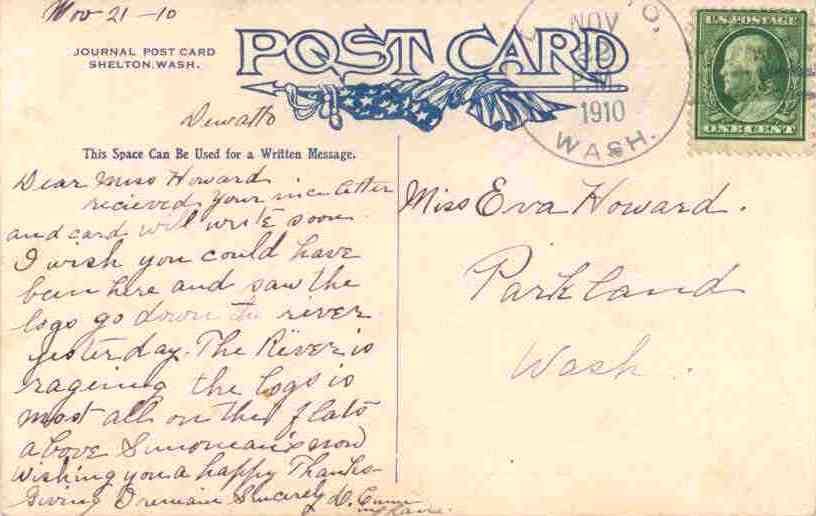
Log Train at Rollway
Log Train at Rollway Mason County Washington

by Mary Katherine May
Here is a great postcard mailed on November 22, 1910, from
Dewatto, Washington. There are two
interests going on with this postcard, both subjects which have been perennial
favorites among deltiological collectors.
The subject matter is (1) trains, and (2) logging.
 |
| Log Train at Rollway, Mason County, Washington
Postmarked Dewatto, Washington, 22 November 1910
|
On the post card back, upper left, we are told that this is
a Journal Post Card, Shelton, Wash. It
is a comfortable assumption to make that the post card was printed/published by
the local Mason County Journal, a weekly publication coming out of Shelton,
Washington. Notice how the American flag
is wrapped around the flag pole. I also
notice how few large diameter logs are on each flatbed, and since I know very
little about the transport of logs by train, I cannot assume that it was
possible to pile them as high as was done on the wagons that would bring the
hewn logs out of the woods.
Reading (scroll down the link page) about Mason County,
Washington, and the logging industry, I learned that after the Panic of 1893
great effort was taken to put loggers back to work, and that the advent of
steam locomotives in this area helped both the logging industry as well as
aided in clearing land for agriculture.
FreeDictionary.com defines what a rollway is: an incline
down which logs are rolled for transportation.
In regard to real photo postcards, the image on this post
card is not a RPPH. If you look closely,
you will see that the image is comprised tiny dots which a type of printing called halftone.
DEWATTO, WASH.
 |
| November 21, 1910. Dear Miss Howard... |
Nov 21 --10
Dewatto
Dear Miss Howard,
received your nice letter and card will write soon. I wish you could have been here and saw the
logs go down the river yesterday. The
river is rageing the logs is most all on the flats above Simoneau's now wishing
you a happy Thanksgiving
I remain
Sincerely
D. Cunningham







